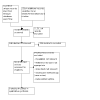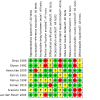Red flags to screen for vertebral fracture in patients presenting with low-back pain
- PMID: 38014846
- PMCID: PMC10683370
- DOI: 10.1002/14651858.CD008643.pub3
Red flags to screen for vertebral fracture in patients presenting with low-back pain
Abstract
Editorial note: See https://www.cochranelibrary.com/cdsr/doi/10.1002/14651858.CD014461.pub2/full for a more recent review that covers this topic and has superseded this review.
Background: Low-back pain (LBP) is a common condition seen in primary care. A principal aim during a clinical examination is to identify patients with a higher likelihood of underlying serious pathology, such as vertebral fracture, who may require additional investigation and specific treatment. All 'evidence-based' clinical practice guidelines recommend the use of red flags to screen for serious causes of back pain. However, it remains unclear if the diagnostic accuracy of red flags is sufficient to support this recommendation.
Objectives: To assess the diagnostic accuracy of red flags obtained in a clinical history or physical examination to screen for vertebral fracture in patients presenting with LBP.
Search methods: Electronic databases were searched for primary studies between the earliest date and 7 March 2012. Forward and backward citation searching of eligible studies was also conducted.
Selection criteria: Studies were considered if they compared the results of any aspect of the history or test conducted in the physical examination of patients presenting for LBP or examination of the lumbar spine, with a reference standard (diagnostic imaging). The selection criteria were independently applied by two review authors.
Data collection and analysis: Three review authors independently conducted 'Risk of bias' assessment and data extraction. Risk of bias was assessed using the 11-item QUADAS tool. Characteristics of studies, patients, index tests and reference standards were extracted. Where available, raw data were used to calculate sensitivity and specificity with 95% confidence intervals (CI). Due to the heterogeneity of studies and tests, statistical pooling was not appropriate and the analysis for the review was descriptive only. Likelihood ratios for each test were calculated and used as an indication of clinical usefulness.
Main results: Eight studies set in primary (four), secondary (one) and tertiary care (accident and emergency = three) were included in the review. Overall, the risk of bias of studies was moderate with high risk of selection and verification bias the predominant flaws. Reporting of index and reference tests was poor. The prevalence of vertebral fracture in accident and emergency settings ranged from 6.5% to 11% and in primary care from 0.7% to 4.5%. There were 29 groups of index tests investigated however, only two featured in more than two studies. Descriptive analyses revealed that three red flags in primary care were potentially useful with meaningful positive likelihood ratios (LR+) but mostly imprecise estimates (significant trauma, older age, corticosteroid use; LR+ point estimate ranging 3.42 to 12.85, 3.69 to 9.39, 3.97 to 48.50 respectively). One red flag in tertiary care appeared informative (contusion/abrasion; LR+ 31.09, 95% CI 18.25 to 52.96). The results of combined tests appeared more informative than individual red flags with LR+ estimates generally greater in magnitude and precision.
Authors' conclusions: The available evidence does not support the use of many red flags to specifically screen for vertebral fracture in patients presenting for LBP. Based on evidence from single studies, few individual red flags appear informative as most have poor diagnostic accuracy as indicated by imprecise estimates of likelihood ratios. When combinations of red flags were used the performance appeared to improve. From the limited evidence, the findings give rise to a weak recommendation that a combination of a small subset of red flags may be useful to screen for vertebral fracture. It should also be noted that many red flags have high false positive rates; and if acted upon uncritically there would be consequences for the cost of management and outcomes of patients with LBP. Further research should focus on appropriate sets of red flags and adequate reporting of both index and reference tests.
Copyright © 2023 The Cochrane Collaboration. Published by John Wiley & Sons, Ltd.
Conflict of interest statement
No conflicts of interest are declared.
Figures








































Update of
-
Red flags to screen for vertebral fracture in patients presenting with low-back pain.Cochrane Database Syst Rev. 2013 Jan 31;(1):CD008643. doi: 10.1002/14651858.CD008643.pub2. Cochrane Database Syst Rev. 2013. Update in: Cochrane Database Syst Rev. 2023 Nov 28;11:CD008643. doi: 10.1002/14651858.CD008643.pub3. PMID: 23440831 Updated.
References
References to studies included in this review
Deyo 1986 {published data only}
-
- Deyo RA, Diehl AK. Lumbar spine films in primary care: current use and effects of selective ordering criteria. Journal of General Internal Medicine 1986;1:20-5. - PubMed
Gibson 1992 {published data only}
Henschke 2009 {published data only}
-
- Henschke N, Maher CG, Refshauge KM, Herbert RD, Cumming RG, Bleasel J, et al. Prevalence of and screening for serious spinal pathology in patients presenting to primary care settings with acute low back pain. Arthritis & Rheumatism 2009;60(10):3072-80. [MEDLINE: ] - PubMed
Patrick 1983 {published data only}
-
- Patrick JD, Doris PE, Mills ML, Friedman J, Johnston C. Lumbar spine x-rays: a multihospital study. Annals of Emergency Medicine 1983;12(2):84-7. - PubMed
Reinus 1998 {published data only}
-
- Reinus WR, Strome G, Zwemer Jr FL. Use of lumbosacral spine radiographs in a level II emergency department. American Journal of Roentgenology 1998;179(2):443-7. - PubMed
Roman 2010 {published data only}
Scavone 1981 {published data only}
-
- Scavone JG, Latshaw RF, Rohrer GV. Use of lumbar spine films. Statistical evaluation at a university teaching hospital. JAMA 1981;246:1105-8. - PubMed
van den Bosch 2004 {published data only}
-
- den Bosch MA, Hollingworth W, Kinmonth AL, Dixon AK. Evidence against the use of lumbar spine radiography for low back pain. Clinical Radiology 2004;59(1):69-76. - PubMed
References to studies excluded from this review
Durham 1995 {published data only}
-
- Durham RM, Luchtefeld WB, Wibbenmeyer L, Maxwell P, Shapiro MJ, Mazuski JE. Evaluation of the thoracic and lumbar spine after blunt trauma. American Journal of Surgery 1995;170(6):681-4. [MEDLINE: ] - PubMed
Frankel 1994 {published data only}
-
- Frankel H, LRozycki GS, Ochsner MG, Harviel JD, Champion HR. Indications for obtaining surveillance thoracic and lumbar spine radiographs. Journal of Trauma 1994;37(4):673-6. [MEDLINE: ] - PubMed
Gestring 2002 {published data only}
-
- Gestring ML, Gracias VH, Feliciano MA, Reilly PM, Shapiro MB, Johnson JW, et al. Evaluation of the lower spine after blunt trauma using abdominal computed tomographic scanning supplemented with lateral scanograms. Journal of Trauma 2002;53(1):9-14. - PubMed
Holmes 2003 {published data only}
-
- Holmes JF, Panacek EA, Miller PQ, Lapidis AD, Mower WR. Prospective evaluation of criteria for obtaining thoracolumbar radiographs in trauma patients. Journal of Emergency Medicine 2003;24(1):1-7. - PubMed
Hsu 2003 {published data only}
-
- Hsu, JM, Joseph T, Ellis AM. Thoracolumbar fracture in blunt trauma patients: Guidelines for diagnosis and imaging. Injury 2003;34(6):426-33. - PubMed
Samuels 1993 {published data only}
-
- Samuels LE. Routine radiologic evaluation of the thoracolumbar spine in blunt trauma patients: a reappraisal. Journal of Trauma 1993;34(1):85-9. [MEDLINE: ] - PubMed
Terregino 1995 {published data only}
-
- Terregino CA, Ross SE, Lipinski MF, Foreman J, Hughes R. Selective indications for thoracic and lumbar radiography in blunt trauma. Annals of Emergency Medicine 1995;26(2):126-9. - PubMed
Additional references
Bigos 1994
-
- Bigos SJ, Braen GR, Deyo RA, Hart J, Keller R, Liang M, et al. Acute low back problems in adults. Clinical practice guideline no. 14. Rockville, MD: Agency for Health Care Policy and Research, Public Health Service, U.S. Department of Health and Human Services, 1994.
Cauley 2007
-
- Cauley JA, Hochberg MC, Lui LY, Palermo L, Ensrud KE, Hillier TA, et al. Long-term risk of incident vertebral fractures. JAMA 2007;298:2761-7. - PubMed
Chou 2007
-
- Chou R, Qaseem A, Snow V, Casey D, Cross JT Jr, Shekelle P, et al. Diagnosis and treatment of low back pain: a joint clinical practice guideline from the American College of Physicians and the American Pain Society. Annals of Internal Medicine 2007;147(1):478-91. [PMID: ] - PubMed
Chou 2009
-
- Chou R, Fu R, Carrino JA, Deyo RA. Imaging strategies for low-back pain: systematic review and meta-analysis. Lancet 2009;373:463-72. - PubMed
Chou 2011
-
- Chou R, Qaseem A, Owens DK, Shekelle P, Clinical Guidelines Committee of the American College of Physicians. Diagnostic imaging for low back pain: advice for high-value health care from the American College of Physicians. Annals of Internal Medicine 2011;154(3):181-9. - PubMed
Cooper 1993
-
- Cooper C, O'Neill T, Silman A. The epidemiology of vertebral fractures. European Vertebral Osteoporosis Study Group. Bone 1993;14(Suppl 1):S89-97. - PubMed
Damiano 2006
-
- Damiano J, Kolta S, Porcher R, Tournoux C, Dougados M, Roux C. Diagnosis of vertebral fractures by vertebral fracture assessment. Journal of Clinical Densiometry 2006;9:66-71. - PubMed
Deeks 2009
-
- Deeks JJ, Bossuyt PM, Gatsonis C (editors). Cochrane Handbook for Systematic Reviews of Diagnostic Test Accuracy Version 1.0.1 [updated March 2009]. The Cochrane Collaboration, 2009. Available from: http://srdta.cochrane.org/.
Delmas 2001
-
- Delmas PD, Watts N, Eastell R, Ingersleben G, de Langerijt L, Cahall DL. Under diagnosis of vertebral fractures is a worldwide problem: The IMPACT Study. Journal of Bone and Mineral Research 2001;16(Suppl.1):S139. - PubMed
Edmond 2005
-
- Edmond SL, Kiel DP, Samelson EJ, Kelly-Hayes M, Felson DT. Vertebral deformity, back symptoms, and functional limitations among older women: the Framingham Study. Osteoporosis International 2005;16:1086–95. - PubMed
Ensrud 1999
-
- Ensrud KE, Nevitt MC, Palermo L, Cauley JA, Griffith JM, Genant HK, et al. What proportion of incident morphometric vertebral fractures are clinically diagnosed and vice versa? Journal of Bone and Mineral Research 1999;14:S138. - PubMed
Ensrud 2000
-
- Ensrud KE, Thompson DE, Cauley JA, Nevitt MC, Kado DM, Hochberg MC, et al. Prevalent vertebral deformities predict mortality and hospitalization in older women with low bone mass. Fracture Intervention Trial Research Group. Journal of the American Geriatric Society 2000;48:241-9. - PubMed
Ferrar 2000
-
- Ferrar L, Jiang G, Barrington NA. Identification of vertebral deformities in women: comparison of radiological assessment and quantitative morphometry using morphometric radiography and morphometric X-ray absorptiometry. Journal of Bone and Mineral Research 2000;15:575-85. - PubMed
Ferrar 2005
-
- Ferrar L, Jiang G, Adams J, Eastell R. Identification of vertebral fractures: An update. Osteoporosis International 2005;16:717-28. - PubMed
Ferrar 2008
-
- Ferrar L, Jiang G, Schousboe JT, DeBold CR, Eastell R. Algorithm-based qualitative and semi-quantitative identification of prevalent vertebral fracture: agreement between different readers, imaging modalities, and diagnostic approaches. Journal of Bone and Mineral Research 2008;23:417-24. - PubMed
Flynn 2011
Freedman 2008
-
- Freedman BA, Potter BK, Nesti LJ, Giuliani JR, Hampton C, Kuklo TR. Osteoporosis and vertebral compression fractures - continued missed opportunities. Spine Journal 2008;8:756-62. - PubMed
Genant 1993
-
- Genant HK, Wu CY, Kuijk C, Nevitt MC. Vertebral fracture assessment using a semi-quantitative technique. Journal of Bone and Mineral Research 1993;8:1137–48. - PubMed
Grigoryan 2003
Hancock 2008
Hasserius 2005
-
- Hasserius R, Karlsson MK, Jonsson B, Redlund-Johnell I, Johnell O. Long-term morbidity and mortality after a clinically diagnosed vertebral fracture in the elderly - a 12- and 22-year follow-up of 257 patients. Calcified Tissue International 2005;76:235-42. - PubMed
Henschke 2008
-
- Henschke N, Maher CG, Refshauge KM. A systematic review identifies five "red flags" to screen for vertebral fracture in patients with low back pain. Journal of Clinical Epidemiology 2008;61(2):110-8. - PubMed
Henschke 2010a
Johnell 2006
-
- Johnell O, Kanis JA. An estimate of the worldwide prevalence and disability associated with osteoporotic fractures. Osteoporos International 2006;17:1726-33. - PubMed
Koes 2010
Lijmer 1999
-
- Lijmer JG, Mol BW, Heisterkamp S, Bonsel GJ, Prins MH, Meulen JH, et al. Empirical evidence of design-related bias in studies of diagnostic tests. JAMA 1999;282(11):1061-6. [PMID: ] - PubMed
Lindsay 2001
-
- Lindsay R, Silverman SL, Cooper C, Hanley DA, Barton, Broy S, et al. Risk of new vertebral fracture in the year following a fracture. JAMA 2001;285(3):320-3. - PubMed
Maitland 2001
-
- Maitland GD, Banks K, English K, Hengeveld E. Maitland’s Vertebral Manipulation. 6th edition. Boston: Butterworth-Heinemann, 2001.
Melton 2003
-
- Melton 3rd LJ. Adverse outcomes of osteoporotic fractures in the general population. Journal of Bone and Mineral Research 2003;18:1139–41. - PubMed
NHMRC 2003
-
- National Health and Medical Research Council Australia (NHMRC). Evidence-based management of acute musculoskeletal pain. Bowen Hills, Queensland: Australian Academic Press, 2003.
Papaioannou 2002
-
- Papaioannou A, Watts NB, Kendler DL, Chui KY, Adachi JD, Ferko N. Diagnosis and management of vertebral fractures in elderly adults. American Journal of Medicine 2002;113:220-8. - PubMed
Rea 2000
-
- Rea JA, Chen MB, Li J. Morphometric X-ray absorptiometry and morphometric radiography of the spine: a comparison of prevalent vertebral deformity identification. Journal of Bone and Mineral Research 2000;15:564-74. - PubMed
Samelson 2011
Schousboe 2006
-
- Schousboe JT, Ensrud KE, Nyman JA. Cost-effectiveness of vertebral fracture assessment to detect prevalent vertebral deformity and select postmenopausal women with a femoral neck T-score > 2.5 for alendronate therapy: a modeling study. Journal of Clinical Densitometry 2006;9:133-43. - PubMed
Suarez‐Almazor 1997
-
- Suarez-Almazor ME, Belseck E, Russell AS, Mackel JV. Use of lumbar radiographs for the early diagnosis of low back pain. Proposed guidelines would increase utilization. JAMA 1997;277:1782-6. - PubMed
Underwood 2009
-
- Underwood M. Diagnosing acute nonspecific low back pain: time to lower the red flags? Arthritis and rheumatism 2009;Oct;60(10):2855-7. - PubMed
van der Windt 2010
-
- Windt DAWM, Simons E, Riphagen II, Ammendolia C, Verhagen AP, Laslett M, et al. Physical examination for lumbar radiculopathy due to disc herniation in patients with low-back pain. Cochrane Database of Systematic Reviews 2010, Issue 2. Art. No: CD007431. [DOI: 10.1002/14651858.CD007431.pub2] - DOI - PubMed
van Tulder 2004
-
- Tulder M, Becker A, Bekkering T, Breen A, Gil del Real MT, Hutchinson A, et al. European guidelines for the management of acute nonspecific low back pain in primary care. European Commission COST B13; Available at www.backpaineurope.org (accessed Dec 8, 2009), 2004. - PMC - PubMed
Vokes 2006
-
- Vokes T, Bachman D, Baim S. Vertebral fracture assessment: the 2005 ISCD official positions. Journal of Clinical Densitometry 2006;9:37-46. - PubMed
Waddell 2004
-
- Waddell G. The Back Pain Revolution. 2nd edition. London: Churchill Livingstone, 2004.
Whiting 2003
-
- Whiting P, Rutjes A, Reitsma J, Bossuyt P, Kleijnen J. The development of QUADAS: a tool for the quality assessment of studies of diagnostic accuracy included in systematic reviews. BMC Medical Research Methodology 2003;3:25; available from http://www.biomedcentral.com/1471-2288/3/25. [DOI: 10.1186/1471-2288-3-25] - DOI - PMC - PubMed
Williams 2010
-
- Williams CM, Maher CG, Hancock MJ, McAuley JH, McLachlan AJ, Britt H, ET AL. Low back pain and best practice care: A survey of general practice physicians. Archives of Internal Medicine 2010;170(12):1088. - PubMed
References to other published versions of this review
Publication types
MeSH terms
LinkOut - more resources
Full Text Sources
Medical
Miscellaneous

